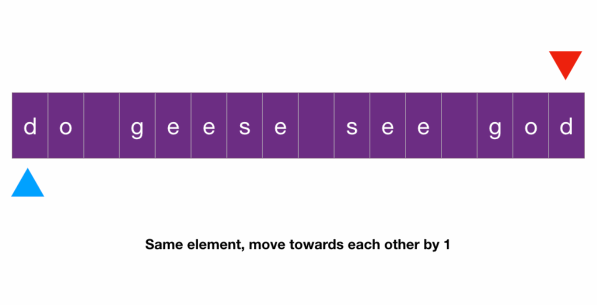Two Pointers: Opposite Direction
Valid Palindrome
Determine whether a string is a palindrome, ignoring non-alphanumeric characters and ignore case.
Examples:
Input: Do geese see God?
Output: True
Input: Was it a car or a cat I saw?
Output: True
Input: A brown fox jumping over
Output: False
- solution 1
function isAlphabet(c) {
return /^[a-zA-Z0-9]*$/.test(c);
}
function isPalindrome(s) {
let left = 0;
let right = s.length - 1;
while (left < right) {
while (!isAlphabet(s[left]) && left < right) left++;
while (!isAlphabet(s[right]) && left < right) right--;
if (s[left].toLowerCase() !== s[right].toLowerCase()) {
return false;
}
left++;
right--;
}
return true;
}
- solution 2
function isLetter(code) {
if (((code >= 48) && (code <= 57)) // numbers
|| ((code >= 97) && (code <= 122))) { // lowercase
return true
}
return false
}
function isPalindrome(s) {
s = s.toLowerCase();
let start = 0;
let end = s.length - 1;
while (start < end) {
while (!isLetter(s.charCodeAt(start)) && start < end) {
start++;
}
while (!isLetter(s.charCodeAt(end)) && start < end) {
end--;
}
if (s.charAt(start) != s.charAt(end)) {
return false;
}
start++;
end--;
}
return true;
};
Explanation

- This is a straightforward two-pointer problem
- We have two pointers l and r starting from the leftmost and rightmost position and moving towards each other
- At each step, if the elements they point to are the same we move each pointer one position towards each other
- If the elements under the pointers are different at any step, then the string is not a palindrome
- Note that the problem asks us to ignore all non-alphanumeric characters
- So any time we see one we have to skip it by incrementing the corresponding pointer only
- Note that:
- We need a while loop here because there could be multiple non-alphanumeric characters in a row
- and we want to skip all of them
- We need to do bound checking in the inner while loop too since while incrementing l or decrementing r
- the outer loop condition l < r could be broken
- and the next line if
s[l].lower() != s[r].lower()would be invalid when l < r does not hold
- We need a while loop here because there could be multiple non-alphanumeric characters in a row
- The time complexity is
O(N)- since we only look at each character at most once
- space complexity is
O(1)- since we didn't allocate a dynamic amount of memory